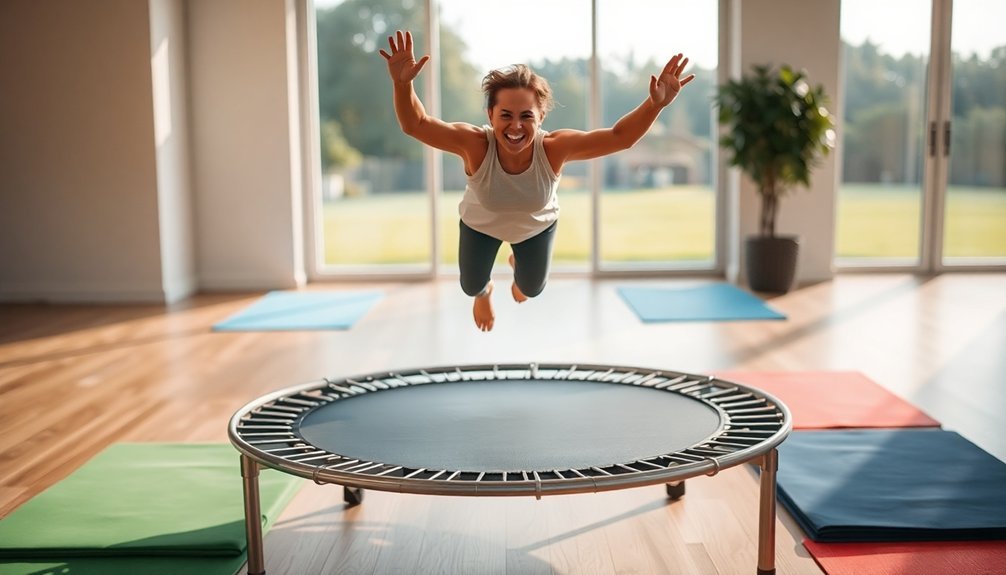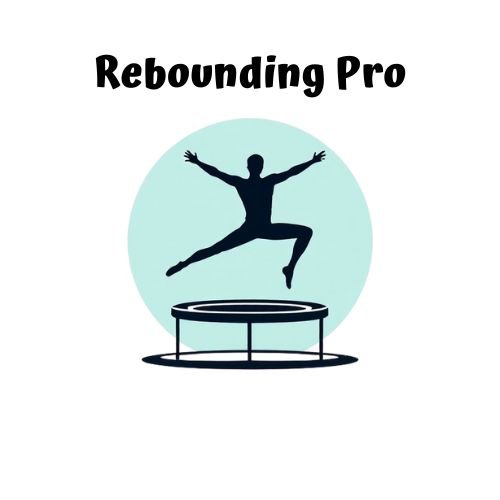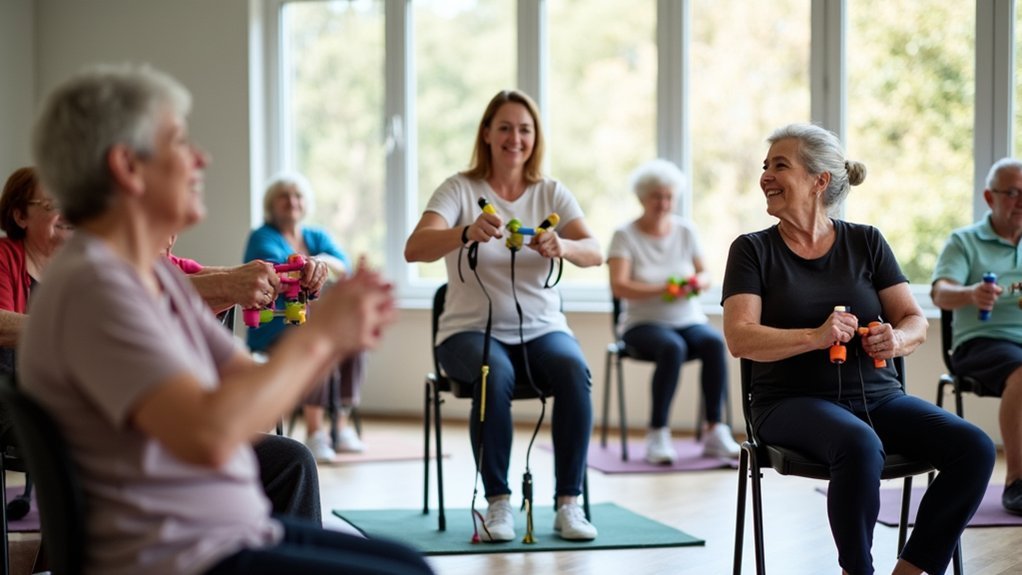Rebounding on a trampoline greatly improves your balance by challenging proprioception and strengthening stabilizer muscles from feet to core. The bouncy surface reduces joint impact by 80% compared to running while enhancing your nervous system's balance pathways. Just 10 minutes of gentle bouncing can develop ankle stability, core strength, and dynamic balance that transfers to everyday movements. Discover how this low-impact exercise can transform your stability in as little as three sessions per week.
The Science Behind Rebounding and Balance Development

While many exercise forms claim to improve balance, rebounding stands out as a scientifically-backed method that delivers remarkable results. The mini-trampoline's unstable surface challenges your proprioception—your body's awareness of its position in space—with every bounce.
When you rebound, you're engaging all your stabilizer muscles from feet to hips while strengthening your core. This dynamic movement incorporates controlled falls that train your body to maintain equilibrium. Research demonstrates that rebounding can reduce impact forces on joints by about 80% compared to running on hard surfaces.
Studies by Miklitsch and Sisi confirm significant improvements in balance and mobility through regular rebounding practice.
Research demonstrates that consistent rebounding sessions measurably enhance stability and movement capabilities.
What makes rebounding particularly effective is how it stimulates your nervous system, enhancing neurological pathways that control balance. Unlike high-impact exercises, rebounding delivers these benefits without stressing your joints, making it accessible for all ages and fitness levels.
5 Essential Trampoline Movements to Build Core Stability
Core stability on a trampoline starts with proper pelvic alignment, which you'll master through controlled bounces that engage your lower abdominals.
You can strengthen your ankles with stabilization sequences that involve single-leg balances and controlled landings on the rebounding surface.
Rotational movements like twists and knee drives across your body will activate your deep core muscles, creating a foundation for better balance in all your daily activities. The 10-minute workout led by Coach Ashley Wimoni effectively combines these movements with cardiovascular elements to maximize your training efficiency.
Rebounding for Pelvic Alignment
As you bounce on a mini-trampoline, your body naturally aligns itself in response to gravity's constant pull. This gentle rebounding action strengthens your pelvic floor muscles while improving bladder control and core stability.
The low-impact nature makes it ideal for maintaining pelvic health without straining joints.
To maximize pelvic alignment during your trampoline sessions:
- Begin with light bouncing to engage your core and pelvic floor muscles
- Incorporate heel drops while maintaining a relaxed pelvic floor (avoid clenching)
- Practice forward-backward bounces to enhance balance and core control
- Add slow, controlled squats and twists to activate broader muscle groups
Remember to empty your bladder before exercising and stay hydrated throughout. Always ensure your knees remain softly bent to effectively encourage lymph flow while protecting your joints.
With consistent practice, you'll develop greater pelvic stability and potentially reduce incontinence issues.
Ankle Stabilization Sequences
Strengthening your ankles serves as the foundation for total-body stability and balance improvement on a mini-trampoline. These dynamic movements not only reduce injury risk but enhance your athletic performance through improved coordination. Using a smaller, portable trampoline provides a convenient way to work on ankle stabilization anywhere in your home or outdoor space.
| Exercise | Benefit |
|---|---|
| Single-Leg Bounces | Core engagement and unilateral strength |
| Trampoline Prances | Quick footwork stabilization |
| In/Out Jumps | Ankle flexibility through stance changes |
| Back/Forth Bounces | Dynamic balance improvement |
| Footwork Drills | Enhanced agility and reaction time |
For maximum effectiveness, combine these trampoline exercises with off-equipment strengthening like seated calf raises and deficit shin raises. Remember to maintain proper posture and landing techniques throughout your workout. The low-impact nature of trampolining makes it ideal for developing ankle stability without stressing your joints.
Rotational Core Engagement
Rotational movements on a mini-trampoline activate your deepest core muscles in ways traditional floor exercises simply can't match.
As you twist and turn on the unstable surface, your obliques, abdominals, and lower back constantly engage to maintain balance. Regular practice of these movements contributes to injury risk reduction in everyday activities.
Try these dynamic rotational exercises to strengthen your core:
- Knee-to-Elbow Twists – Bounce gently while bringing opposite knees and elbows together
- Standing Torso Rotations – Keep feet planted while rotating your upper body from side to side
- Jumping Jacks with Twist – Add a torso rotation at the top of each jumping jack
- Single-Leg Rotational Hops – Balance on one leg while gently rotating your body 90 degrees with each bounce
These movements not only build core stability but also improve spinal mobility and coordination while reducing stress.
Why Gentle Bouncing Protects Your Joints While Strengthening Balance
You'll experience considerably less joint stress with each gentle bounce on a trampoline compared to high-impact exercises like running or jumping on hard surfaces.
The unstable surface challenges your proprioception and core muscles, naturally improving your balance with every movement. Similar to using bungee cords, the trampoline provides varying resistance that adjusts to your range of motion while supporting your body weight.
While you're having fun bouncing, your body is actually strengthening the muscles around your joints, creating a protective effect that enhances your stability for everyday activities.
Low-Impact Joint Protection
When traditional high-impact exercises like running or jumping jacks become too harsh on aging or sensitive joints, gentle bouncing offers a revolutionary alternative that protects your body while improving balance.
The elastic surface of trampolines or rebound boots absorbs shock, creating a cushioning effect that's gentler on your body while still providing effective exercise.
Here's how bouncing protects your joints while enhancing stability:
- Reduces joint stress by minimizing impact forces that typically strain knees and hips
- Improves synovial fluid circulation to better lubricate and nourish joint tissues
- Strengthens supporting muscles around joints for added stability and protection
- Enhances vestibular function to improve your balance and coordination in daily activities
Consistent gentle bouncing can help maintain joint flexibility which becomes increasingly important as we age when joints naturally become stiffer with less movement.
Dynamic Stability Training
Dynamic stability training transforms gentle bouncing into a powerful method for enhancing your body's balance systems. By incorporating movements like single-leg hops and plyometrics, you'll challenge your core and improve reflexes that protect you during everyday activities.
Unlike static exercises, dynamic stability training mimics real-life movements, strengthening your mind-body connection and proprioception. You'll notice improved coordination as your body learns to make quick adjustments to maintain balance. The training significantly enhances your core strength and overall stability.
Start with stable surfaces before progressing to tools like balance boards or stability balls. Listen to your body and advance gradually to prevent injury.
The benefits extend beyond the gym—you'll experience enhanced mobility, better body awareness, and reduced fall risk in daily life. For ideal results, maintain proper form and consider working with a fitness professional to tailor exercises to your needs.
Gravity-Defying Balance Benefits
Gentle bouncing on a trampoline creates a unique gravity-defying environment where your body can build balance while safeguarding your joints.
Unlike high-impact exercises, trampoline workouts absorb shock through the elastic surface, protecting your joints while still challenging your stability.
Your body benefits in four distinct ways:
- Reduced Joint Stress – The trampoline's surface absorbs up to 80% of impact compared to running on hard surfaces.
- Enhanced Neuromuscular Control – Your brain constantly recalibrates position during bouncing, improving coordination.
- Core Engagement – Your abdominal muscles work continuously to maintain stability.
- Bone Density Improvement – The gentle resistance helps strengthen bones without harmful impact.
You'll notice improved stability in everyday movements as your body adapts to maintaining balance during multidirectional trampoline exercises. Rebounding also dramatically improves lymphatic drainage, helping your body eliminate toxins more efficiently.
From Trampoline to Real Life: Balance Improvements That Matter
The balance skills you develop on a trampoline don't just stay there—they transfer remarkably well to everyday life. Your improved dynamic balance directly enhances functional mobility for daily activities like maneuvering through crowded spaces or walking on uneven surfaces. A recent study on 26 young adults demonstrated that just six weeks of trampoline training produced significant improvements in dynamic balance.
| Balance Improvement | Real-Life Benefit |
|---|---|
| Enhanced sensory motor integration | Better adaptation to shifting centers of gravity |
| Stronger postural muscles | Improved body positioning during activities |
| Refined neuromuscular responses | Quicker reactions to prevent falls |
You'll notice practical changes: increased gait stability, reduced fear of falling, and better muscle coordination. The progressive nature of trampoline training—gradually increasing difficulty—helps you build balance skills that apply to real-world situations. Even mini-trampolines offer these benefits for those with mobility concerns.
Combining Rebounding With Other Balance Techniques for Maximum Results

Combining your trampoline workouts with other balance-focused exercises creates a powerful synergy that amplifies results beyond what either approach can achieve alone.
The fusion of rebounding and specialized balance training creates a transformative synergy that unlocks superior stability gains.
This cross-training approach strengthens different muscle groups and challenges your neuromuscular system in complementary ways. Working with a bellicon mini trampoline provides exceptional support for engaging both lymphatic and cardiovascular systems simultaneously.
To maximize your balance improvement:
- Integrate ankle stability exercises like standing on one foot while brushing your teeth to complement your rebounding practice.
- Add bodyweight squats on your mini-trampoline to engage stabilizer muscles that aren't activated during regular bouncing.
- Practice mindful rebounding by focusing on your core engagement and breathing patterns during each session.
- Incorporate single-leg exercises both on and off the trampoline to build glute strength and improve overall stability.
Creating a Sustainable Balance Routine Through Regular Rebounding
Establishing a sustainable rebounding routine requires more than just occasional bounces—it demands strategic consistency that transforms sporadic exercise into lasting balance improvements.
Start with short, manageable sessions of 5-10 minutes daily, gradually increasing duration as your endurance builds.
You'll achieve excellent results by incorporating rebounding at least 3-4 times weekly. The low-impact nature makes it ideal for daily practice without risking joint strain or overexertion.
Consider alternating between focused balance exercises and more vigorous bouncing to thoroughly develop your spatial awareness and coordination. Rebounding significantly improves balance and coordination, helping reduce risks associated with degenerative diseases.
Track your progress to stay motivated—many people notice improved stability within weeks of consistent practice.
Frequently Asked Questions
How Does Age Affect Balance Improvements From Rebounding Exercises?
Your balance improvements from rebounding vary by age: children develop motor skills, adults strengthen core muscles, and seniors greatly enhance stability and reduce fall risks while enjoying low-impact benefits throughout life.
Can Rebounding Help Those With Existing Balance Disorders?
Yes, you'll likely benefit from rebounding if you have balance disorders. It improves sensory-motor stimulation, vestibular function, and motor coordination. Research shows it's especially promising for those with Parkinson's disease and other neurological conditions.
What Safety Precautions Should Beginners Take When Starting Trampoline Exercises?
You should wear protective gear, use safety harnesses, start with simple exercises, and always have supervision. Guarantee your trampoline has safety pads and netting. Don't attempt flips or jumps near the edges.
How Quickly Can Someone Expect to See Balance Improvements?
You'll typically notice balance improvements within 4-6 weeks of consistent training. Most people see significant changes after 12 weeks. Practice at least three times weekly for ideal results and faster progress.
Are Mini-Trampolines as Effective as Full-Sized Ones for Balance Training?
Mini-trampolines are just as effective as full-sized ones for balance training. You'll get similar benefits while enjoying more convenience, lower cost, and space efficiency. Both develop your stability through dynamic movement challenges.
In Summary
You've now discovered how rebounding can transform your balance abilities. Start slow, build gradually, and you'll notice improvements in everyday activities. By incorporating these bouncing exercises into your regular routine, you're not just having fun—you're developing core strength and stability that'll serve you for years to come. Remember, consistency is key. Commit to your rebounding practice and watch your balance flourish.





Leave a Reply